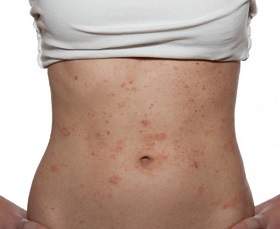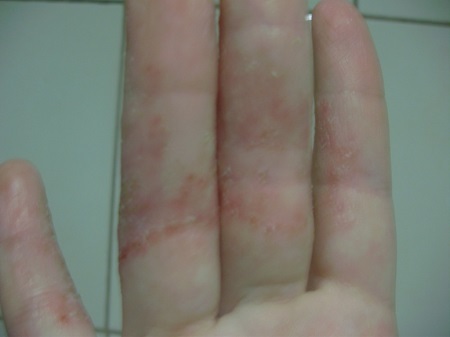 What is it: eczema - an inflammatory skin disease of an allergic etiology, characterized by a tendency to relapses, the main symptoms are manifested in the form of rash, itching and burning on the skin.
What is it: eczema - an inflammatory skin disease of an allergic etiology, characterized by a tendency to relapses, the main symptoms are manifested in the form of rash, itching and burning on the skin.
According to statistics, eczema accounts for approximately 40% of all skin diseases. As a rule, pathology begins in childhood and passes into a chronic form with incorrect treatment.
As a rule, with this disease the skin becomes dry, reddens and itches. Cracks may appear on it. Eczema can occur on any part of the body, but more often it appears on the legs and hands.
By the nature of development, seborrheic, true, microbial and occupational eczema are distinguished. Depending on the features of the course of the disease, they are dry and wet.
From this article you will find out what it is, the causes of its occurrence, the symptoms and, of course, how to treat eczema and what kind of doctor to turn to.
Classification
Since many factors contribute to the onset of pathology, several types of eczema are isolated depending on the cause, the location of affected areas and the nature of the manifestations of the disease:
- true;
- microbial;
- mycotic (fungal);
- seborrheic;
- dishydrotic;
- professional.
Causes of Eczema
 What it is? Eczema can develop with nervous disorders and when there are abnormalities in the endocrine system. Chronic infections and diseases of the gastrointestinal tract can also trigger the onset of the disease.
What it is? Eczema can develop with nervous disorders and when there are abnormalities in the endocrine system. Chronic infections and diseases of the gastrointestinal tract can also trigger the onset of the disease.
There are several kinds of specimens that influence the causes of their occurrence:
- The disease begins to develop under the influence of external factors (synthetic tissues, flowers, chemicals, dyes and so on further) and internal: hereditary predisposition, diseases of the endocrine system, diseases of the gastrointestinal tract;
- Seborrheic - begins to develop due to the negative impact of microbes (staphylococcus, fungus of the genus Candida), against the background of disorders in the digestive and endocrine systems;
- Microbial - begins to manifest itself against the background of pustular lesions of the skin, mycoses, varicose veins, after infection of burns;
- Professional - allergies are caused by chemical irritants that come in contact with open skin areas.
However, the main cause of the disease is considered to be the allergic reaction of the human body to any food product or external stimulus.
Symptoms of Eczema
Depending on the type of eczema and the stage of development of the inflammation process, the symptoms of eczema can differ on the skin.
For all types of eczemaa number of general symptoms, such as:
- on the skin appears a site of limited inflammation, it is characterized by reddening (in some cases, blue) of the skin, the appearance of the skin thickened;
- on the site of inflammation a rash is formed, depending on the type of ailment the rash may have its own peculiarities;
- there is a skin itch that can be of a permanent nature, thereby disrupting daily activities and affecting sleep,
- if the rash bubbles are opened, painful wounds and cracks appear in their place;
- In times of exacerbation of eczema, there is often an increase in body temperature;
- after the inflammation subsides, the skin becomes dry, loses its former elasticity, begins to crack.
For the chronic form of the disease are characterized by periods of exacerbations that occur with active hyperemia, rashes and drip wetness.
Eczema photo: the initial stage
What does the initial stage of eczema look like on the photo:
 Eczema on the hands of the initial stage
Eczema on the hands of the initial stageThe microbial
It is localized around scratches, abrasions, trophic ulcers, fistulas and infected wounds. The onset of the disease is determined by the appearance on the skin of large, sharply outlined inflammatory foci of the disease, on the surface of which papulovezicles, seropapules, erect erosions and purulent crusts are formed. The development of microbial eczema is accompanied by severe burning and unbearable itching.
Seborrheic
Practically in 80% of cases this form develops in patients who have lipophilic yeast fungus Pityrosporum ovale in the lesions. Also, seborrhea and associated neuroendocrine disorders can provoke the development of the disease.
Itching and inflammation with seborrheic eczema are insignificant, the boundaries of the eczematous foci are clear. Often, the pathological process extends to the scalp and is accompanied by the appearance of dandruff. Hair in patients fatty, dull and glued.
True
Most often localized on the back of the hands and face. In an acute period, rashes are numerous. After the opening of the inflamed vesicles, small point erosions are formed, releasing the serous fluid. The disease is accompanied by severe itching. Often eczema is complicated by a secondary infection.
Professional
Occurs on the skin area most often in contact with the irritant (usually the skin of the hands). The main symptoms with occupational eczema are the same as with true: skin itching, redness of the skin, the appearance of bubbles that open and form crusts. The aggravation of the disease occurs after each contact with the stimulus.
Dysgidrotic
It stands out by the concentration of erosion on the palms, and also the soles. The vesicles either open or dry up, turning into serous-purulent crusts, or unite into multi-chambered blisters. Over time, the focus of inflammation spreads to the hands, feet. Often, the dyshidrotic form of the disease is distinguished by trophic changes in the nails.
Than to treat an eczema
Treatment of eczema dermatologist selects individually for each patient, taking into account the type of disease, degree the severity of manifestations of the inflammatory process, as well as individual characteristics of a person.
There are many options for treating eczema, first of all, it is prescribed:
- Hypoallergenic dietfor a period of up to six months (except for the ration of smoked foods, pickles, canned food, spices, chocolate, alcohol, citrus fruits with the transition to dairy and vegetable food).
- Elimination of contact with allergens, and this includes the rejection of cosmetic products, detergents, synthetic clothing, wearing bandages for protection of damaged skin from excessive insolation, wind, snow, cold, refusal of water procedures.
- Treatment of concomitant diseasesand sanation of foci of chronic infection.
- Ingestion of medications: antiallergic drugs (suprastin, zirtek, erius) to relieve itching, soothing (valerian, motherwort, sedatives), small tranquilizers, vitamins (vitamins C, group B, A, E, P), calcium preparations.
- Local treatment: astringent and disinfecting lotions and solutions, cream, paste and powder (zinc, talc, starch). With prolonged course of eczema hormonal preparations are used in the form of ointments and aerosols (hydrocortisone, Lorinden C, fluorocort).
Also, for the effectiveness of treatment, it is necessary to eliminate the effects of all factors of skin irritation (dirt, dampness, sun radiation, skin parasites, chemicals, etc.).
The diet of patients should be full and rational for protein, minerals and vitamins. The diet includes the required amount of amino acids, as well as trace elements (cobalt, zinc, sulfur). You need to start treating eczema as early as possible. It is important to consider the stage of the disease.
How to treat eczema folk remedies
Folk remedies should be used as an auxiliary therapy after consultation with a dermatologist.
- Grated raw potatoes - lotions 2 r / d.
- Application of grated raw potatoes and honey - ½ cup potatoes mixed with 1 h / l honey. Apply the paste for 2 hours with a bandage.
- Currant leaves and fruits of the viburnum - their mixture pour boiling water, after cooling to make lotions.
- Strong broth from the dried bark of a young willow: when symptoms of eczema wash off damaged skin. Carry out 3-4 procedures.
- With a wetting type, poultices from a cabbage leaf cooked in milk and mixed with bran are helpful (1-2 p / d).
- With a dry form, poultices from cranberry juice help.
In addition, do not forget that the treatment of eczema requires strict adherence to a special diet, spa and physiotherapy.
Ointments and cream from eczema
The main way to treat eczema are ointments and creams containing hormones (corticosteroids). Thanks to these tools, it is possible to accelerate the healing process of wounds and cracks in the skin, as well as reduce the intensity of inflammation.
- Elokomis available in the form of a cream, ointment and lotion and, when properly used, relieves inflammation and weakens the symptoms of eczema. Elokom is recommended to apply on the skin in the area of inflammation with a thin layer once a day. Duration of treatment is determined by the attending physician.
- Cream AdvantanIt is recommended for very dry skin, for example, with a dyshidrotic type of disease. Cream Advantan, as a rule, is prescribed with eczema in the stage of wetting. The medicine is applied to the skin with a thin layer once a day. The duration of treatment is determined by the attending physician and can be several months.
- Lokoidis available as a cream and ointment, which should be applied to the skin in the area of inflammation 3-4 times a day for several weeks.
It should be remembered that local products containing corticosteroids have side effects: thinning of the skin, propensity to join fungal and bacterial infections, etc., in connection with which their appointment is carried out only by the attending physician.
Diet
Compliance with hypoallergenic diet is an essential part of the program, which will cure eczema. Patients are advised to limit the use of liquid and digestible carbohydrates, refuse alcohol, spicy and salty foods, marinades, extractives and canned foods.
At the same time, patients are advised to enrich their diet with porridge, milk dishes, greens, vegetables, boiled meat and fruits (except citrus fruits).

How to choose probiotics for the intestine: a list of drugs.

Effective and inexpensive cough syrups for children and adults.

Modern non-steroidal anti-inflammatory drugs.

Review of tablets from the increased pressure of the new generation.
 Antiviral drugs are inexpensive and effective.
Antiviral drugs are inexpensive and effective.



